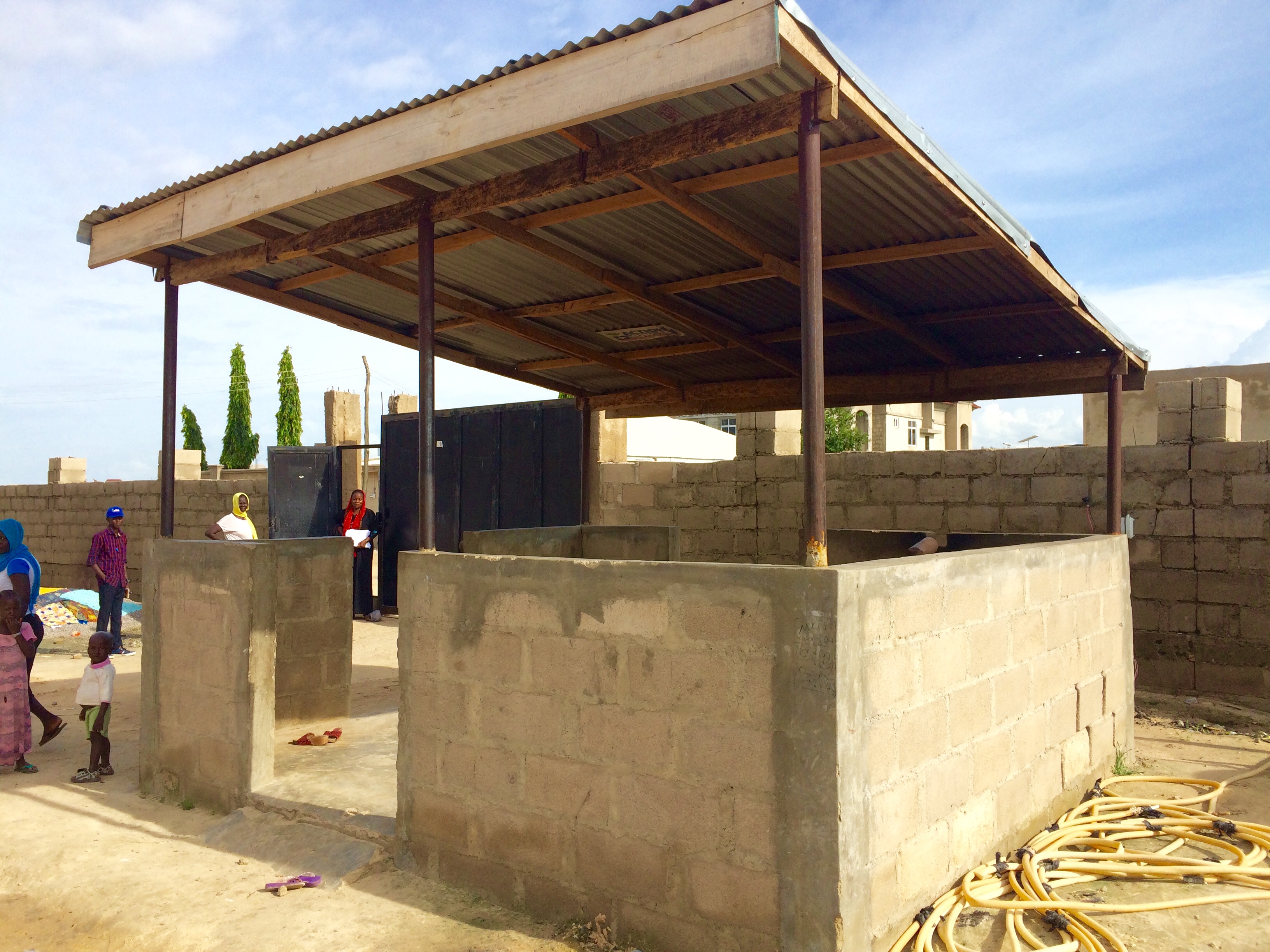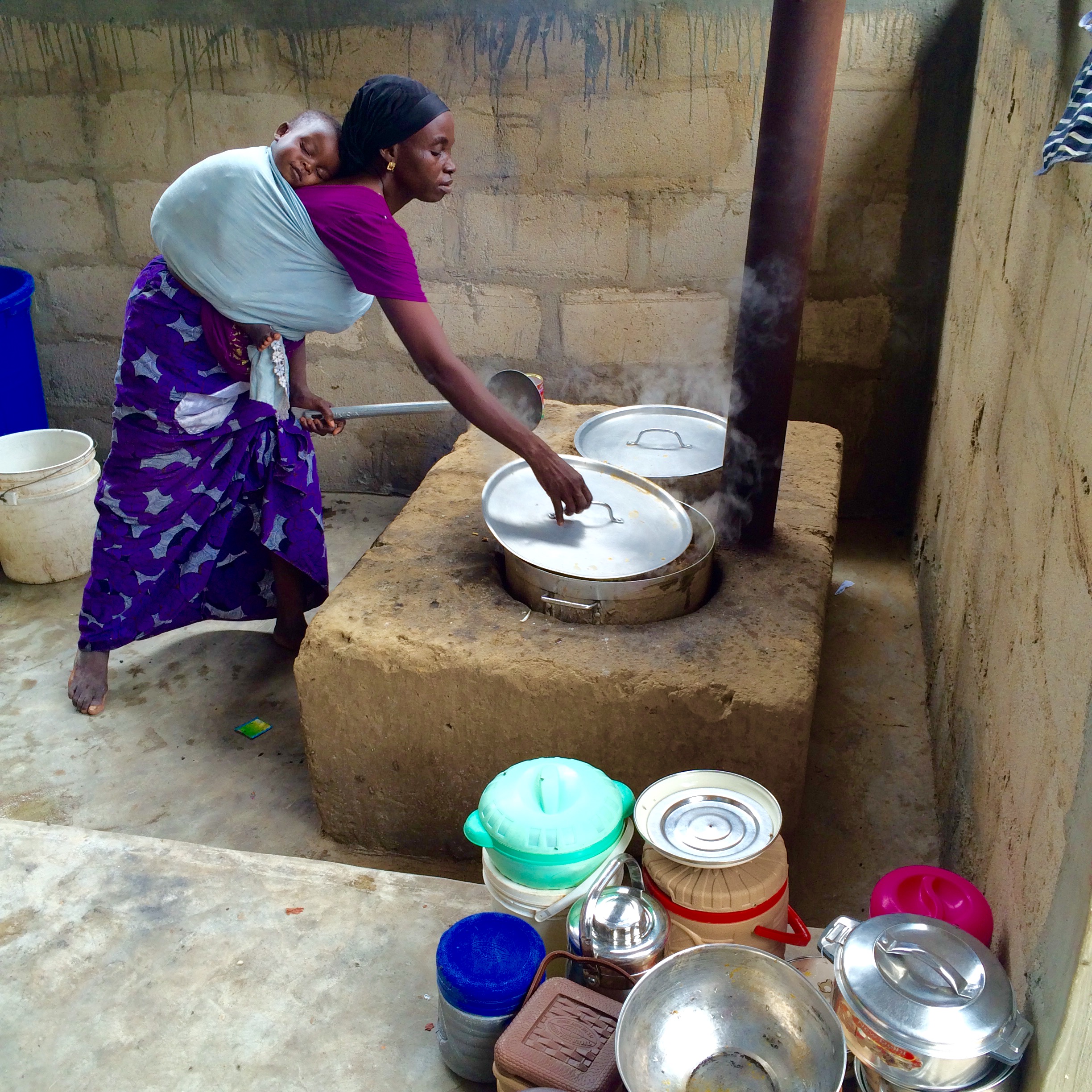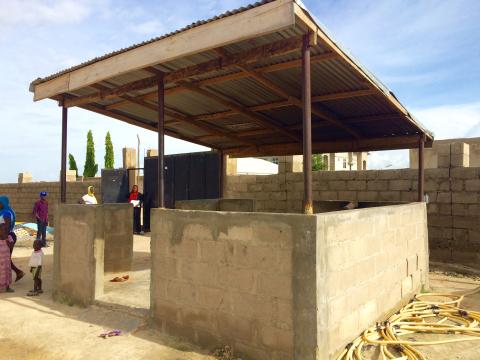Learning from the Porridge Mums project in northeast Nigeria
By Ellyn Yakowenko and Silke Pietzsch
Ellyn Yakowenko is the Associate Director of Research at Action Against Hunger USA, supporting a portfolio of research projects. She led the original case study on the ‘Porridge Mums’ approach in Nigeria on which aspects of this article are based.
Silke Pietzsch is the Technical Director at Action Against Hunger USA. She has been involved in the implementation and adaptation of multi-sector, nutrition-sensitive interventions for over ten years. Together with Maureen Gallagher, she developed the concept behind the Porridge Mums pilot project.
Action Against Hunger USA would like to acknowledge Maureen Gallagher, former Senior Nutrition and Health Adviser, who was instrumental in conceptualising the Porridge Mums approach. The authors also acknowledge support and contributions of the Action Against Hunger Nigeria teams at both mission (Abuja) and field (Maiduguri) levels and the support and services of community leaders and traders who make these activities possible. Finally, thanks to the beneficiaries of the programme who were willing and generous in sharing their time, stories and experiences.
Location: Northeast Nigeria
What we know: Care group models are sometimes used in emergency settings to enable access to food, infant and young child feeding (IYCF) education and to facilitate mother-to-mother support.
What this article adds: In 2014 Action Against Hunger Nigeria initiated a programme to improve the nutrition of internally displaced persons (IDPs) in northeast Nigeria which included IYCF support groups. Pregnant and lactating women (PLW) and their children under five years of age were provided with one supplementary meal per day via community kitchens, monthly IYCF education sessions, safe spaces for PLW to gather, and mid-upper arm circumference (MUAC) screenings. Porridge Mums (PMs) functioned well in groups of 12-15 women; adaptations included rotation of recipes, redesigned stoves and shared kitchens between groups, which helped increase coverage. Success factors included: acceptance of some food sharing among non-beneficiaries; understanding the social dynamics of members from different villages or communities; involvement of community leaders; adequate training for staff, including facilitation and community mobilisation skills; cross-linkages with other programmes for consistency and complementarity; and willingness of all involved to adapt to changing needs.
Introduction
Since 2009, populations living in northeast Nigeria have been deeply affected by the continued violence and insecurity caused by the Boko Haram insurgency. Borno State continues to host the most internally displaced persons (IDPs) (nearly 1.5 million)1, with repeated attacks continuing to undermine livelihoods and overwhelm a humanitarian response. Most (80%) of these IDPs live in informal settlements and have experienced protracted displacement (one year or more). Since 2014 Action Against Hunger Nigeria has implemented the ‘Protecting and Promoting the Food and Nutrition Security of IDPs in Borno State, northeast Nigeria’ project, funded by the United States Agency for International Development Office of Food for Peace (USAID/FFP). This programme is comprised of two components: a cash-based, food-assistance programme that ensures access to a nutritious family food basket; and Porridge Mums (PM) – infant and young child feeding (IYCF) support groups that provide a platform for women to come together, learn and discuss improved care and feeding practices. The PM approach was based on identified needs from a March 2015 assessment conducted in Maiduguri and Jere local government areas in Borno State, which indicated low dietary diversity for children under five years old. This article details Action Against Hunger’s learning through implementation of the PM approach.
Methodology
Data collection was undertaken in a ten-day visit to Maiduguri in August 2016. Qualitative data collection methods involved four focus-group discussions with select PM groups; ten key informant interviews with PM leaders and vendors; 14 interviews and a facilitated GOAL exercise2 with Action Against Hunger staff; six site visits to additional PM kitchens; and a review of relevant project-related documentation. The field visit was also aligned with two project-closure meetings with stakeholders in Maiduguri, which served to further triangulate and elaborate the data collected for the case study.
The Porridge Mums (PM) approach
The PM design was based on a modified care group model for mother-to-mother (M2M) support in emergency settings, using cash transfer and adapted fuel-efficient stove components to facilitate the group cooking of nutritious, complementary meals. The main difference is that the care group model focuses on education, while the PM approach combines the group definition and educational component with wet feeding. The approach centres on the provision of one supplementary, nutritious meal per day to pregnant and lactating women (PLW) and their children under five years of age, as well as the promotion of optimal IYCF practices through education sessions; the facilitation of M2M support on healthy caring practices; the provision of safe spaces for mothers to gather, rest and discuss; and the monitoring of nutritional status through monthly mid-upper arm circumference (MUAC) screenings.
Targeting and coverage
Box 1: Location and targeting criteria for PM groups
Locations for the PM groups were determined based on the following criteria:
- Informal settlements and most vulnerable communities;
- Overlapping with Action Against Hunger food assistance and communities/settlements receiving WASH support;
- Confirmed by State Nutrition Officer as nutritional hotspot;
- Can identify a safe cooking space for the group.
Key entry criteria for group members were: female, PLW and mothers or caretakers of children under five years old, interested in nutrition and health issues, positive attitude and motivation to serve neighbours, and respected and trusted in the community. Literacy was not necessary (other than for the roles of secretary and treasurer).
The original plan was for 40 PM groups, each with 25 women, and the construction of one kitchen per group. In practice, however, this group size was too large to function effectively. Furthermore, the PLW/mother/caregiver criteria (Box 1) were not met in the initial pilot groups; hence groups were restructured to 12-15 women and the full eligibility criteria implemented. This led to the formation of 68 PM groups. New kitchens could not be built for the additional 28 groups, so arrangements were made for them to share kitchens with existing groups, with a maximum of two groups per kitchen. Mobilisers approached community leaders to identify whom they would like to be part of a group, or selected women themselves. This approach led to high group motivation and cohesion; however it did not necessarily ensure that the most vulnerable women, most likely to benefit from the programme, participated. Certainly, there were some women who met the eligibility criteria who were unable to participate as groups were already full and one non-PM beneficiary mother presented to Action Against Hunger staff with a severely ill child, requiring immediate treatment. Future projects may need to reconsider increasing their resource allocation to ensure that all women meeting eligibility criteria within a given community can participate, possibly through the formation of two or more groups per neighbourhood.

Group functioning
Each PM group had two identified literate group leaders, a secretary and a treasurer, who were responsible for managing the group’s resources, including documenting foods purchased and number of beneficiaries receiving a meal each day. In a small number of groups where a literate leader could not be identified, an adolescent, typically without children, took responsibility for the leadership position.
Overall, PM groups seemed to function well in practice. On a rotational basis, group members prepared the daily nutritious meal for all. Women are reported to have actively participated in the monthly lessons. Dynamics evolved from eating separately (mothers taking their food home to eat) to eating together in the kitchen. Across all PMs visited as part of the study, participants were grateful for the assistance provided and emphasised how much they would like to continue the daily meals and monthly lessons.
Vouchers and cash transfers
Each PM group received an electronic voucher transfer using closed-loop smart cards, restricted to commodities associated with the group’s daily meal to redeem at local vendor shops3. While many vendors were located in more distant larger markets, more local vendors were also part of the project. Mothers reported that the trips to the larger markets were beneficial as they consolidated additional shopping.
For the first few months of the project, all groups cooked ‘Tom Brown’ porridge (a local traditional porridge). Use of just one recipe allowed Action Against Hunger to streamline monthly voucher disbursements, calculated based on specific commodities needed. However, participants quickly got tired of this, so local project staff added additional recipes to the group’s recipe repertoire with a two-week cycle. Voucher disbursements were realigned accordingly. The cost was based on 120 Nigerian Naira (0.38USD) per meal.
Action Against Hunger provided cooking equipment (three cooking pots and cooking spoons) and covered additional meeting costs, transport costs (for two group members), firewood, grinding services and water. There were no major challenges with the e-voucher distribution; minor issues (delays in smart cards, card loss, broken card chips and delays with vendors acquiring atypical commodities) were resolved successfully. Vendors interviewed reported positive experiences and beneficiaries reported no problems.
Kitchen structures and construction
Action Against Hunger adapted the ‘Lorena stove’ model from east Africa to local design options, materials and services. A kitchen design with a larger physical footprint was chosen to provide shade and sufficient space for gathering, as well as a stove that would allow for group cooking (using large pots) and efficient cooking (using less fuel and generating less smoke). Permission was sought from the land owners and, in most cases, approval was readily given for construction; this was a critical step where displaced populations and communities were settled in compounds that were already owned or claimed in some form, even if not legally. Subsequent problems with flooding in the kitchen area during onset of the rainy season, which reduced use of and access to space for cooking, were easily resolved using tarpaulin sheets. Problems with smoke ventilation were also corrected in existing and new kitchen designs.

Porridge Mum recipes and nutrition educational lessons
Recipes for the PM project were derived from the Working to Improve Nutrition in Northern Nigeria (WINNN) programme Food Demonstration Manual that was developed around local foods common to Jigawa, Katsina, Kebbi, Yobe and Zamfara States of northern Nigeria and recipe cards were distributed to each group. A lesson plan for PM groups was developed in the initial stages of the project by Action Against Hunger nutrition staff based on the national IYCF guidelines and the WINNN-specific, IYCF community-based, education session materials.
Each month the Action Against Hunger Nutrition Officer develops a full, detailed lesson plan and trains each PM Nutrition Assistant to deliver the sessions to their groups. Topics include: maternal nutrition and the importance of a balanced diet (including micronutrient supplementation), breastfeeding and complementary feeding across age groups, good hygiene practices, and growth monitoring and promotion. Each session opens by exploring existing knowledge from the group about the theme of the month. The Nutrition Assistant then delivers the lesson, actively encouraging questions and exchange of experiences and concerns, seeks additional information, explains any risks of current practices and provides a counselling card for follow-up discussions.
Areas of new knowledge cited across groups as helpful included various breastfeeding positions; how to determine the consistency of the porridge (i.e. not making it too watery); how to tell if the baby is unhealthy (e.g. rashes) and if/when they should seek treatment; practices to improve personal hygiene (including critical times to wash hands); and which types of food fall into each food group, including what this means for nutrition overall. Anecdotal feedback showed that the women enjoyed learning new recipes and using them in home cooking and discussed lesson topics with non-beneficiary community members after the sessions.
Main influencing factors
The Action Against Hunger case study identified several factors which appear to have a strong influence on the PM groups, including:
Indirect beneficiaries
There is evidence that some food sharing is occurring in the groups, usually with elderly women or other mothers’ children who visit during mealtimes; the extent of this is unknown. Sharing appears to occur most in neighbourhoods whose populations have highly mixed places of origin or where there are high numbers of women who meet the target criteria who are not enrolled in a PM group. The children of these women who receive food can be counted as indirect beneficiaries. Given the nature of sharing and the near inevitability of some sharing, cultural practices and expectations, implementing agencies must take this into account when designing and monitoring programmes of this type.
Place of origin
One key area of learning was the diversity of community composition across the intervention area and how this affected group dynamics. In some groups, households were from the same place of origin with some type of familial relationship; in others, people were of diverse origin with few familial ties. Where women came from diverse backgrounds, social ties appeared to be strengthened by the peer support of a PM group, especially when women had lost their husbands. In heterogeneous communities, staff observed higher levels of conflict within the group. This will be an important area for future projects to explore in displacement contexts, relating not only to targeting but also to overall implementation, management and sustainability of the PM groups in practice.
Community leadership
Community leaders expressed a clear interest in being more involved in the project from the outset, when groups are formed, construction sites are chosen and care-practice messages are promoted. In many of these displaced communities, traditional leaders are struggling to maintain their positions within traditional cultural norms and practices. By involving community leaders in the process and allowing for a certain level of adaptive management, community leaders can provide a useful platform for the implementation and sustainability of PM groups over time.
Technical training and expertise
Local humanitarian capacities were minimal and nutrition emergency capacities non-existent in Borno at the time of this intervention. Nutrition Assistants were trained in taking MUAC measurements and received an orientation in the operations of PM groups, including IYCF sessions. However, those staff members hired after the start of implementation were not given this training due to a lack of time and increasing needs in the local emergency context. Such frontline staff are key to high-quality programme implementation; we must do better to ensure that all necessary skills are transferred to programme staff, including technical areas, facilitation and community mobilisation. Staff should also be made aware of their pivotal role in the success of the project and outcomes sustainability.
Cross-linkages
The PMs benefited from complementary activities under other projects implemented by Action Against Hunger’s multi-sector response in the region. For example, under the initiative of the Maiduguri field teams, resources from the USAID Office of Foreign Disaster Assistance (USAID/OFDA) supported the construction of several latrines and bathing areas, co-located in those areas where PM kitchens were constructed. Action Against Hunger also capitalised on the earlier WINNN project, using these resources as a technical springboard for the lessons. The WINNN IYCF cards used in the educational sessions are also in line with messages of the Government of Nigeria, ensuring consistency across stakeholders and durability of messages. These examples demonstrate that a small investment of time and interest to assess pre-emergency and development interventions prior to project implementation can help avoid reinventing the wheel and synergise resources.
Adaptation
Project staff have been alert to the needs of the beneficiaries and have been flexible and nimble in their reactiveness to field realities. This was possible due to the close relationship and understanding between the project team and the PM groups and a flexible donor. If we, as the humanitarian community, are serious about finding effective solutions in these situations, we must push for adaptation and creativity to better support populations in need.
Phase 2 developments
The project has now entered a second phase, with some modification of the original PM activities based on lessons learned, as follows:
- In phase 2, targeting criteria (PLW with children under five years old) have been clarified from the start, with group size limited to around 15 women. Group composition has been organised by maternal characteristics and age of children as follows: pregnant mothers, lactating mothers with infants under six months old, lactating mothers with children from six to 24 months, and mothers with children from two to five years. The number of groups has been scaled up to 80, with the goal of reaching 1,200 PLW and their children.
- The provision of supplementary food vouchers has been limited to four months, after which households are intended to provide their own food to be cooked at the communal kitchen on a biweekly basis. These households will already be receiving food assistance through vouchers, so will have the resources needed for food diversification.
- Groups will choose and validate one lead mother who will be trained on promoting IYCF behaviours and cascade this training among the group. Participants of the PM activity are intended to act as change agents in their community by cascading the nutrition education they have received to people living around them. This is expected to increase dietary diversity practices in their communities.
- The process of data collection will be improved to ensure consistency and aid proper analysis.
A costing exercise is planned to compare PMs with the care group model and wet feeding separately. This should be completed by end of 2017.
For more information contact: Ellyn Yakowenko eyakowenko@actionagainsthunger.org or Silke Pietzsch spietzsch@actionagainsthunger.org
1The cash-based food assistance program had a number of components, of which the PMs were a small proportion of the total population served. In the programme, a large range of vendors was contracted to participate in the electronic smart-card food-assistance transfers. The PM vendors were a subset of total vendors participating in the cash-based programme.
2IOM DTM Nigeria Report Round 11, August 2016#.
3The GOAL exercise helped to define good practices related to the approach by facilitating a discussion around those aspects that the team wants to keep, eliminate, acquire/add/achieve or avoid in the future. Together these aspects create a goal for how to adapt the approach for the next implementation period.


